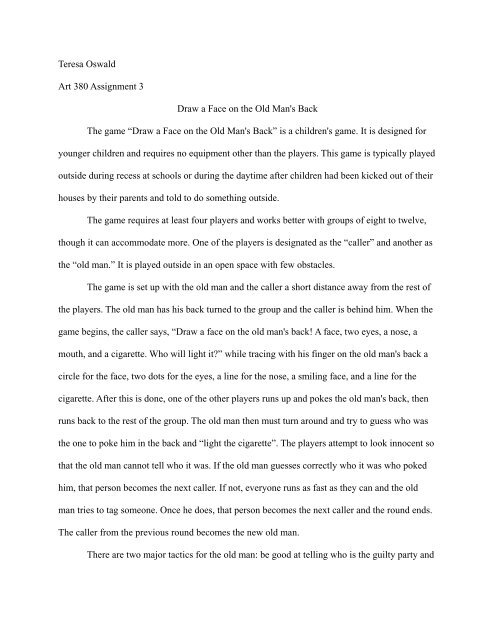Draw a Face on the Old Man's Back - Umbc
Draw a Face on the Old Man's Back - Umbc
Draw a Face on the Old Man's Back - Umbc
You also want an ePaper? Increase the reach of your titles
YUMPU automatically turns print PDFs into web optimized ePapers that Google loves.
Teresa Oswald<br />
Art 380 Assignment 3<br />
<str<strong>on</strong>g>Draw</str<strong>on</strong>g> a <str<strong>on</strong>g>Face</str<strong>on</strong>g> <strong>on</strong> <strong>the</strong> <strong>Old</strong> <strong>Man's</strong> <strong>Back</strong><br />
The game “<str<strong>on</strong>g>Draw</str<strong>on</strong>g> a <str<strong>on</strong>g>Face</str<strong>on</strong>g> <strong>on</strong> <strong>the</strong> <strong>Old</strong> <strong>Man's</strong> <strong>Back</strong>” is a children's game. It is designed for<br />
younger children and requires no equipment o<strong>the</strong>r than <strong>the</strong> players. This game is typically played<br />
outside during recess at schools or during <strong>the</strong> daytime after children had been kicked out of <strong>the</strong>ir<br />
houses by <strong>the</strong>ir parents and told to do something outside.<br />
The game requires at least four players and works better with groups of eight to twelve,<br />
though it can accommodate more. One of <strong>the</strong> players is designated as <strong>the</strong> “caller” and ano<strong>the</strong>r as<br />
<strong>the</strong> “old man.” It is played outside in an open space with few obstacles.<br />
The game is set up with <strong>the</strong> old man and <strong>the</strong> caller a short distance away from <strong>the</strong> rest of<br />
<strong>the</strong> players. The old man has his back turned to <strong>the</strong> group and <strong>the</strong> caller is behind him. When <strong>the</strong><br />
game begins, <strong>the</strong> caller says, “<str<strong>on</strong>g>Draw</str<strong>on</strong>g> a face <strong>on</strong> <strong>the</strong> old man's back! A face, two eyes, a nose, a<br />
mouth, and a cigarette. Who will light it?” while tracing with his finger <strong>on</strong> <strong>the</strong> old man's back a<br />
circle for <strong>the</strong> face, two dots for <strong>the</strong> eyes, a line for <strong>the</strong> nose, a smiling face, and a line for <strong>the</strong><br />
cigarette. After this is d<strong>on</strong>e, <strong>on</strong>e of <strong>the</strong> o<strong>the</strong>r players runs up and pokes <strong>the</strong> old man's back, <strong>the</strong>n<br />
runs back to <strong>the</strong> rest of <strong>the</strong> group. The old man <strong>the</strong>n must turn around and try to guess who was<br />
<strong>the</strong> <strong>on</strong>e to poke him in <strong>the</strong> back and “light <strong>the</strong> cigarette”. The players attempt to look innocent so<br />
that <strong>the</strong> old man cannot tell who it was. If <strong>the</strong> old man guesses correctly who it was who poked<br />
him, that pers<strong>on</strong> becomes <strong>the</strong> next caller. If not, every<strong>on</strong>e runs as fast as <strong>the</strong>y can and <strong>the</strong> old<br />
man tries to tag some<strong>on</strong>e. Once he does, that pers<strong>on</strong> becomes <strong>the</strong> next caller and <strong>the</strong> round ends.<br />
The caller from <strong>the</strong> previous round becomes <strong>the</strong> new old man.<br />
There are two major tactics for <strong>the</strong> old man: be good at telling who is <strong>the</strong> guilty party and
eing able to run really fast. The first largely depends <strong>on</strong> <strong>the</strong> people playing <strong>the</strong> game—if <strong>the</strong>y<br />
are bad at acting, <strong>the</strong>n <strong>the</strong> old man does not need to be good at discerning <strong>the</strong> <strong>on</strong>e who poked<br />
him. O<strong>the</strong>rwise, <strong>the</strong> old man must be fast enough to tag some<strong>on</strong>e. The tagging part has very little<br />
tactics involved as <strong>the</strong> game is usually played in an open field, but <strong>the</strong> old man should c<strong>on</strong>sider<br />
feinting and changing directi<strong>on</strong>s quickly to c<strong>on</strong>fuse <strong>the</strong> runners, or try to tire <strong>the</strong> runners out<br />
while c<strong>on</strong>serving his own energy for a quick burst. As for <strong>the</strong> o<strong>the</strong>r players, <strong>the</strong>y must be careful<br />
about who goes to tag <strong>the</strong> old man at <strong>the</strong> beginning of <strong>the</strong> round. If <strong>the</strong> same pers<strong>on</strong> does it too<br />
many times, <strong>the</strong>n <strong>the</strong> old man will guess that pers<strong>on</strong> more often. Also, if <strong>the</strong> pers<strong>on</strong> who tags <strong>the</strong><br />
old man is not fast enough, he might not be back with <strong>the</strong> rest of <strong>the</strong> group before <strong>the</strong> old man<br />
turns around, or he could be <strong>the</strong> <strong>on</strong>ly pers<strong>on</strong> in <strong>the</strong> group who is out of breath. This game has a<br />
lot of tense emoti<strong>on</strong>s at <strong>the</strong> beginning of <strong>the</strong> round when <strong>the</strong> old man is inspecting <strong>the</strong> group for<br />
signs of who poked him. The players wish to trick <strong>the</strong> old man, so <strong>the</strong> <strong>on</strong>e who did <strong>the</strong> deed tries<br />
to pretend he didn't, while <strong>the</strong> rest of <strong>the</strong> players act as though <strong>the</strong>y had. It is <strong>the</strong> old man's task to<br />
figure out who it was or else he has to chase people around, so he is under pressure to guess<br />
correctly or be subjected to <strong>the</strong> taunting of his fellow players. It is important for <strong>the</strong> caller to<br />
make sure <strong>the</strong> old man is far enough away from <strong>the</strong> rest of <strong>the</strong> players that <strong>the</strong>y can have a decent<br />
head start if <strong>the</strong>y have to run. Also, he must make sure <strong>the</strong> old man does not look too so<strong>on</strong>.<br />
This game is made for a younger generati<strong>on</strong> and seems to be making fun of <strong>the</strong> elderly.<br />
The first part of <strong>the</strong> game is teaching kids how to harass <strong>the</strong> elderly and <strong>the</strong>n lie about it, and<br />
<strong>the</strong>n run for it afterwards. If <strong>the</strong>y get caught by <strong>the</strong> old man, <strong>the</strong>n <strong>the</strong>y have to do an undesirable<br />
job—be <strong>the</strong> caller, who does almost nothing. This is meaningful to children because it relates to<br />
<strong>the</strong>ir lives. They like to rebel against authority, or at least pretend that <strong>the</strong>y do, so <strong>the</strong>y create<br />
games that emulate disobedient behavior without actually being disobedient. Children
<strong>the</strong>mselves probably do not realize <strong>the</strong> meaning of this game, but <strong>the</strong> meaning is clear to adults<br />
who see <strong>the</strong> game played. All in all, this seems like an interesting game. It promotes lying and<br />
dodging resp<strong>on</strong>sibility for acti<strong>on</strong>s, which is great fun for all ages.
References<br />
My Aunt Suzy Oswald, who lives in Beaver, Pennsylvania.











